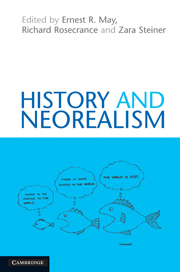Book contents
- Frontmatter
- Contents
- List of tables
- Notes on contributors
- Acknowledgments
- 1 Theory and international history
- 2 Transformations in power
- 3 Domestically driven deviations: internal regimes, leaders, and realism's power line
- 4 How international institutions affect outcomes
- 5 Not even for the seventeenth and eighteenth centuries: power and order in the early modern era
- 6 Austria-Hungary and the coming of the First World War
- 7 British decisions for peace and war 1938–1939: the rise and fall of realism
- 8 Realism and risk in 1938: German foreign policy and the Munich Crisis
- 9 Domestic politics, interservice impasse, and Japan's decisions for war
- 10 Military audacity: Mao Zedong, Liu Shaoqi, and China's adventure in Korea
- 11 The United States' underuse of military power
- 12 The overuse of American power
- 13 Redrawing the Soviet power line: Gorbachev and the end of the Cold War
- 14 Shared sovereignty in the European Union: Germany's economic governance
- 15 John Mearsheimer's “elementary geometry of power”: Euclidean moment or an intellectual blind alley?
- 16 History and neorealism reconsidered
- Index
- References
14 - Shared sovereignty in the European Union: Germany's economic governance
Published online by Cambridge University Press: 05 June 2012
- Frontmatter
- Contents
- List of tables
- Notes on contributors
- Acknowledgments
- 1 Theory and international history
- 2 Transformations in power
- 3 Domestically driven deviations: internal regimes, leaders, and realism's power line
- 4 How international institutions affect outcomes
- 5 Not even for the seventeenth and eighteenth centuries: power and order in the early modern era
- 6 Austria-Hungary and the coming of the First World War
- 7 British decisions for peace and war 1938–1939: the rise and fall of realism
- 8 Realism and risk in 1938: German foreign policy and the Munich Crisis
- 9 Domestic politics, interservice impasse, and Japan's decisions for war
- 10 Military audacity: Mao Zedong, Liu Shaoqi, and China's adventure in Korea
- 11 The United States' underuse of military power
- 12 The overuse of American power
- 13 Redrawing the Soviet power line: Gorbachev and the end of the Cold War
- 14 Shared sovereignty in the European Union: Germany's economic governance
- 15 John Mearsheimer's “elementary geometry of power”: Euclidean moment or an intellectual blind alley?
- 16 History and neorealism reconsidered
- Index
- References
Summary
This chapter explores the question of why West Germany, with the most powerful economy within the European Union (EU), chose to give up its stable, highly prized deutsche mark to join the European Monetary Union (EMU) and accept significant constraints on its fiscal and monetary policies. The answer for Germany lies in a series of historical stages after 1945, each reflecting an increasing acceptance of the need to abandon balance-of-power politics for a multiple-level shared sovereignty through economic and political integration with other EU member states. In domestic policy, West Germany developed a “social partnership” in which power and decision-making was shared among major interest groups. In foreign policy, the parallel system was called a “security partnership” with major and minor powers in Europe and North America. As a result, Germany based its international actions on multilateral institutions such as the United Nations, the North Atlantic Treaty Organization, the Council of Europe, the Conference on Security and Cooperation in Europe, and the European Community (later European Union). Internally this approach ensured that no major interest, neither big business nor labor, would dominate. Internationally the multilateral policy encouraged other states to accept Germany's increasing economic strength without fearing it would be harnessed to national political ambitions. The ultimate proof of the wisdom of this approach was the relative ease with which Germany's neighbors, allies, and rivals accepted the unification of the Federal Republic of Germany and the German Democratic Republic.
- Type
- Chapter
- Information
- History and Neorealism , pp. 307 - 321Publisher: Cambridge University PressPrint publication year: 2010



